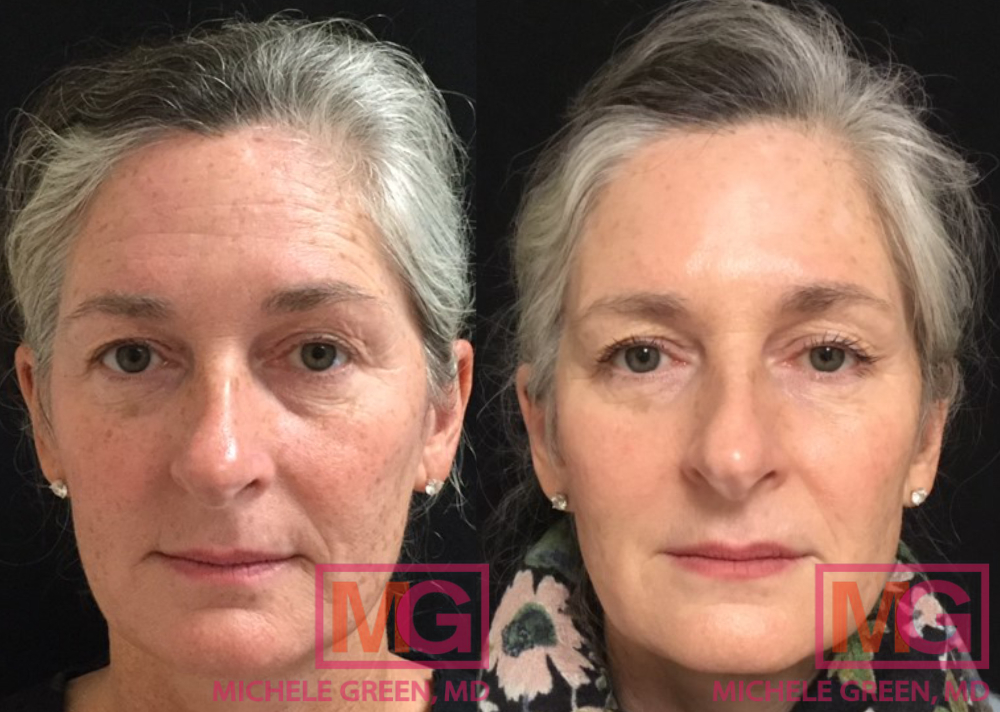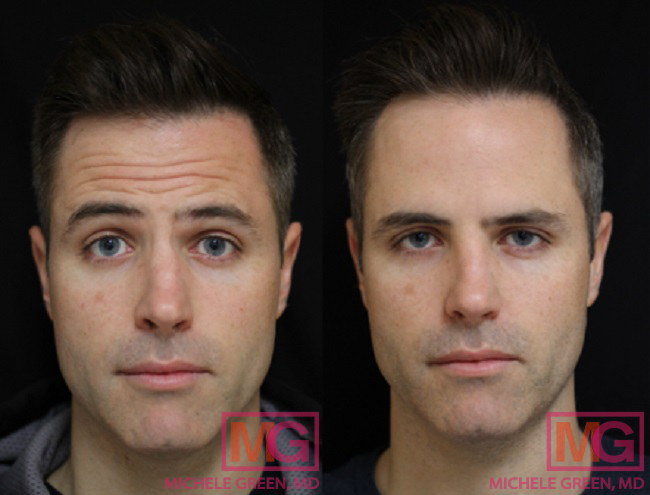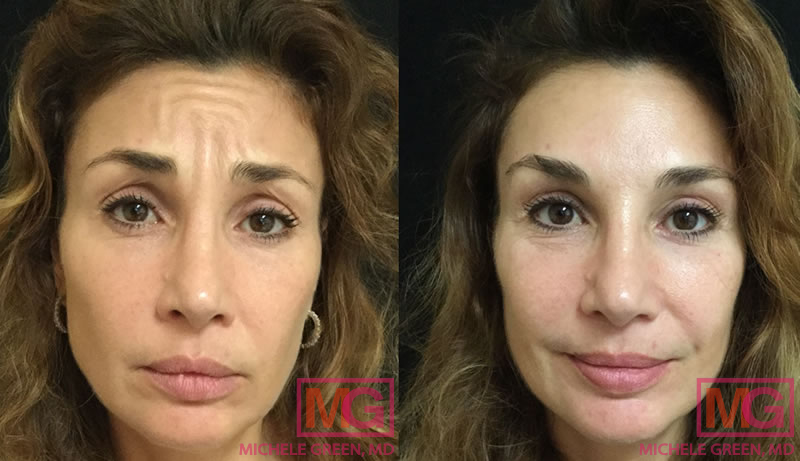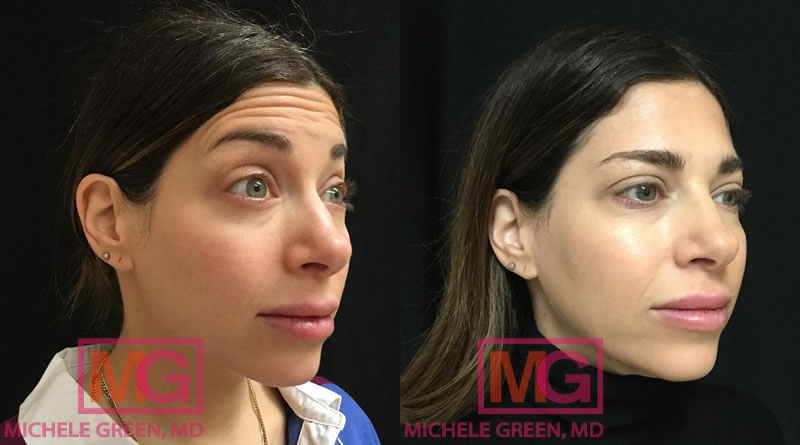Can You Workout After Botox?
Exercise is a key part of maintaining a healthy lifestyle, and many patients wish to incorporate exercise and cosmetic procedures into their busy schedules so they can feel and look their best. Botox injections are among the most popular cosmetic treatments globally, and for good reason. They are a non-invasive procedure designed to treat dynamic fine lines and wrinkles caused by repetitive facial movements and contractions. By essentially “freezing” the muscles responsible for these movements, Botox can help prevent the formation and worsening of fine lines while smoothing the skin in the treated area. Dr. Green was one of the first providers in New York City to use Botox to treat dynamic fine lines and wrinkles, and she artfully injects it into targeted muscles to provide facial rejuvenation for her patients.
While patients often want to incorporate Botox injections and workouts into their daily routine seamlessly, some consideration must be taken to maximize the effects of Botox and minimize any unwanted side effects. Patients can work out before and leading up to their Botox injections. Strenuous exercise should be avoided for roughly two days after treatment to allow the Botox to settle and reduce the risk of additional swelling or bruising. Afterward, patients can quickly resume their regular workout routine and look forward to a refreshed youthful appearance. When you consult with Dr. Green, she will help you devise a timeline for your treatments and exercise plan to help you be your best self inside and out.
Dr. Michele Green is a board-certified dermatologist, an Allergan platinum injector of Botox in NYC, and a leader in cosmetic injectables and non-invasive facial treatments. Dr. Green has been recognized for providing the “best Botox in New York,” with over two decades of experience in Botox injections. Her “less is more” philosophy, and natural-looking results will help you become the best version of yourself. Dr. Green’s unique technique for Botox treatments will make you look younger after just one visit to her boutique private dermatology office in New York City. During your consultation with Dr. Green, she will evaluate your skin concerns to develop a customized cosmetic treatment plan, including the best non-invasive procedures and skin care products to give you precise, radiant skin.
What are Botox injections?
Botox cosmetic is the brand name for the injectable neurotoxin known as botulinum toxin type A, developed by Allergan Aesthetics. When injected into a muscle, Botox inhibits the neurotransmitters that signal the muscle to contract, resulting in muscle relaxation and smoothing of the skin. Since receiving FDA approval for cosmetic use in 2002, Botox has become one of the most popular minimally invasive anti-aging treatments in the United States. Botox works to smooth and prevent facial wrinkles, particularly those that develop from repetitive facial movements and contractions. Common areas for Botox injections include forehead lines from raising the eyebrows, glabellar lines from frowning, and crow’s feet around the eyes from smiling or squinting. Not only does this smooth out existing wrinkles, but it can also train younger patients’ muscles to avoid contraction, thus preventing the formation of deep wrinkles. In addition to Botox, other brands of neuromodulators that serve similar functions to eliminate dynamic wrinkles include Dysport and Xeomin.

What are the aftercare instructions for post-Botox treatment?
Botox injections are quick and straightforward, requiring minimal downtime post-treatment. The most common side effects include mild swelling and bruising around the treated area, which resolve independently within two weeks of treatment. After the procedure, it is essential to stay upright for four hours to settle the Botox. Strenuous aerobic exercise and heat, including saunas or hot tubs, should be avoided for 48 hours to minimize swelling, infection, and migration of Botox. Massaging or applying pressure to the treated area should also be avoided for three days following the procedures. Patients should also avoid taking blood-thinning medications and supplements like aspirin, Aleve, fish oil, and vitamin E for one week after treatment to reduce the risk of bruising. For the best cosmetic results, it is essential to follow the medical advice provided by Dr. Green to ensure that your Botox injections result in beautiful, natural-looking rejuvenation.
Why not exercise after Botox?
While exercise benefits cardiovascular health and overall well-being, it should be avoided for 48 hours after Botox injections. Exercise raises heart rate and blood pressure, may cause patients to bend into an inverted position, and can apply excessive pressure to the injected areas. Increased blood flow to the injection sites can migrate Botox to unintended areas, which may lead to muscle weakness elsewhere. Yoga and Pilates, in particular, may involve holding inversions, which could interfere with how Botox settles into the muscle. Any pressure applied may cause the Botox to move from the injection site — if you often wipe the sweat off while working out, you might unintentionally apply pressure to your face. Additionally, certain activities like cycling or swimming require head or facial gear that can put pressure on common injection sites. Avoiding exercising for 48 hours after the initial injections is essential for optimal Botox results.
Light exercise vs strenuous exercise after Botox
Dr. Green recommends that all her patients avoid aerobic exercise after receiving Botox. Working out increases blood flow, worsening any associated swelling or bruising and potentially increasing the risk of Botox migration. Low-impact activities such as walking or house chores that will not raise the heart rate are okay and will not alter the effects of Botox. After 48 hours, you can begin physical activity with light exercises, such as jogging, and then work up to more strenuous exercise, like weightlifting. When you consult with Dr. Michele Green in her private dermatology office regarding Botox injections, she will review all after-care instructions to create a treatment timeline that fits your schedule.
Can you do cardio after Botox?
Patients should avoid any exercise that elevates their heart rate, including cardio, immediately after receiving Botox injections. Vigorous exercise, such as running, jogging, or biking, can increase heart rate, blood flow, and body temperature, increasing the risk of swelling, bruising, infection, and Botox migration. It is essential to avoid any heavy cardio for at least 48 hours after receiving Botox injections to reduce the risk of any unwanted side effects or cosmetic results.

Other Frequently Asked Questions about Botox and Working Out:
Do you think facial exercises after Botox help?
Performing facial exercises and purposely contracting the facial muscles in the treated areas will not impact the outcomes. However, it is important to refrain from massaging the treatment area for three days after receiving Botox injections, as this can displace Botox and potentially result in undesirable effects. When you consult with Dr. Green for your Botox injections, she will review all aftercare instructions and procedures to ensure optimal results.
Can you exercise after Botox? Can I lift weights after Botox?
Patients should wait at least 48 hours after Botox injections before exercising or lifting weights. Dr. Green often advises patients who want to finish their exercise routine before receiving Botox injections. Exercise and weight lifting can elevate blood pressure and circulation, potentially affecting the recently injected Botox. Increased pressure and circulation may cause Botox to spread into unintended muscles, leading to muscle weakness or drooping eyelids. Additionally, swelling and bruising could worsen and take longer to heal. To ensure the best Botox results, patients should stay upright for 4 hours and avoid strenuous exercise for 48 hours. Refraining from massaging or applying pressure to the treated area for at least three days is essential. To reduce bruising, patients should avoid blood-thinning medications and supplements such as aspirin, Aleve, fish oil, and vitamin E for a week before and after treatment. Following the previous instructions will give patients the best Botox results, leading to a smoother, more youthful complexion.
Should you work out/exercise after Botox?
A common question in Dr. Green’s private dermatology office is, “Can I work out after Botox?” The answer is that patients should wait. Exercise increases circulation to the treated muscles, potentially leading to worse side effects and a higher risk of Botox migration. Increased blood flow to the injection site can exacerbate swelling and bruising while applying additional pressure that may push Botox into other muscles. This can result in eyelid drooping or muscle weakness in the areas surrounding the treatment. To minimize these side effects, Dr. Green advises her patients to work out before getting Botox injections and to avoid exercising for at least 48 hours following the injections.
How long do you wait after Botox to work out? When can you exercise after Botox?
Many patients in Dr. Green’s office often ask, “How long after Botox can I work out?” Dr. Green recommends that her patients wait one day before exercising after receiving Botox. This allows the Botox to settle and helps reduce side effects such as swelling or bruising. Patients who do not want to skip a day of aerobic exercise can work out before the Botox injections without fear of unwanted side effects. Immediately following Botox, patients can engage in gentle activities such as walking or house chores that can be completed upright. After 48 hours, they can integrate more intense exercises, such as jogging or yoga, which forces participants to bend over. Then, patients can return to full activity with strenuous exercises such as heavy weight lifting.

What happens if you exercise after Botox? What happens if I sweat after Botox?
You want to wait to exercise after Botox because exercise increases circulation. Sweat occurs due to an increased heart rate, intense exercise, or high temperatures. What this means for your injections is that the Botox could spread to areas where it wasn’t intended to go and can cause a droop. Sweat can also enter the injection sites, increasing the risk of developing an infection. We always advise patients to keep their heads upright after the injections, and if they need to bend, they should plié like a ballerina. Any exercise that requires you to put your head below your heart, such as yoga or Pilates, can cause your Botox to diffuse to an unintended area. Patients should avoid saunas, which can lead to excessive sweating, raising blood flow, and pressure in the treated area.
What exercises should be avoided after Botox?
Avoid all forms of strenuous activity, including weight lifting and exercises that require bending over, like downward dog in yoga. Additionally, patients should refrain from anything that puts pressure on the area, such as wearing restrictive sports gear, wiping away sweat, jogging or running, participating in contact sports, or engaging in any exercise that elevates heart rate.
Does exercise speed up Botox?
There is no evidence that exercise speeds up the effects of Botox; in fact, it may prolong side effects like swelling and bruising. Raising one’s heart rate during exercise can enhance how the body metabolizes Botox, but no evidence supports this belief. The metabolism of Botox varies among individuals, with some noticing that Botox lasts up to six months while others find that their results last for three months.
Where to get Botox?
The best place to get Botox is at the office of an experienced board-certified dermatologist or plastic surgeon, such as Dr. Green’s New York City Upper East Side office. While getting Botox at an institution like a med spa is usually cheaper due to specials and deals, the risk of developing serious side effects from Botox treatment is higher. An expert injector, on the other hand, knows exactly how much Botox to use and where to place the injections for the best results. Dr. Green typically employs a less-is-more philosophy for Botox injections, providing patients with a naturally youthful look.

How to get started with Botox injections today
Botox injections are a quick and easy solution for treating dynamic fine lines and wrinkles. Many patients opt to include Botox in their routine due to its accessibility and minimal downtime compared to invasive plastic surgery. Individuals are advised to refrain from exercising for 48 hours after Botox injections to enjoy consistently stunning results and a clear complexion. Dr. Green was one of the first physicians in New York to offer cosmetic Botox injections and is recognized for delivering the “best Botox in New York City.” When you consult with Dr. Green, you can guarantee beautiful, natural, youthful-looking results that last.
Dr. Michele Green is an internationally renowned board-certified dermatologist with over two and a half decades of experience providing her patients with the best non-invasive treatment options, including Botox, dermal fillers, laser treatments, and more. Dr. Green takes a holistic approach and embraces a less-is-more philosophy, creating customized skincare routines and treatment plans that cater to unique concerns and aesthetic goals. She is consistently identified as one of New York’s best dermatologists by Castle Connolly, New York Magazine, and Super Doctors for her dedication to her patients and expertise. Please call us at 212-535-3088 or email our New York City-based office today to schedule a consultation with Dr. Michele Green and find the best Botox treatment plan for you.
 212-535-3088
212-535-3088